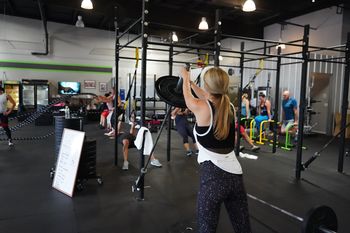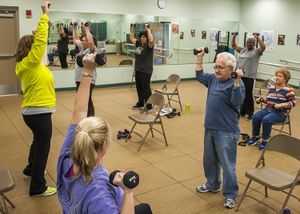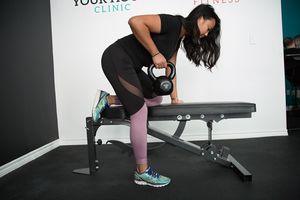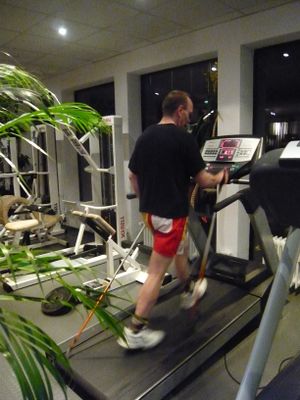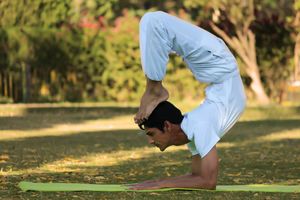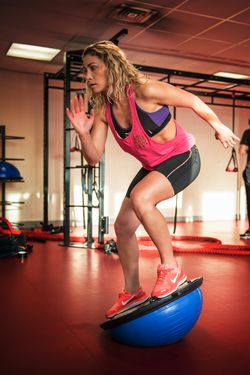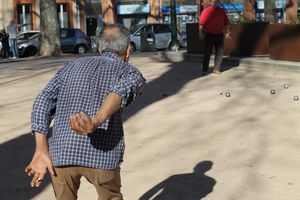Therapeutic Exercise: Difference between revisions
No edit summary |
No edit summary |
||
| Line 116: | Line 116: | ||
== Physiotherapy == | == Physiotherapy == | ||
There is strong evidence that aerobic exercise (40-50% HRR progressing to 60-80%) conducted 20-40 min and 3-5 days per week is beneficial for enhancing aerobic fitness, walking speed and walking endurance in people who have had mild to moderate stroke and are deemed to have low cardiovascular risk with exercise after proper screening assessments<ref>Pang MY, Charlesworth SA, Lau RW, Chung RC. Using aerobic exercise to improve health outcomes and quality of life in stroke: evidence-based exercise prescription recommendations. Cerebrovascular Diseases 2013; 35(1): 7-22.</ref>. Nine articles (seven RCTs) were identified. The exercise intensity ranged from 50% to 80% heart rate reserve. Exercise duration was 20-40 min for 3-5 days a week. The total number of subjects included in the studies was 480. All studies reported positive effects on aerobic capacity, regardless of the stage of stroke recovery. There is good evidence that aerobic exercise is beneficial for improving aerobic capacity in people with mild and moderate stroke. Aerobic exercise should be an important component of stroke rehabilitation<ref>Marco Y C Pang 1, Janice J Eng, Andrew S Dawson, Sif Gylfadóttir. The Use of Aerobic Exercise Training in Improving Aerobic Capacity in Individuals With Stroke: A Meta-Analysis. Clin Rehabil. 2006 Feb;20(2):97-111</ref>. | There is strong evidence that aerobic exercise (40-50% HRR progressing to 60-80%) conducted 20-40 min and 3-5 days per week is beneficial for enhancing aerobic fitness, walking speed and walking endurance in people who have had mild to moderate stroke and are deemed to have low cardiovascular risk with exercise after proper screening assessments<ref>Pang MY, Charlesworth SA, Lau RW, Chung RC. Using aerobic exercise to improve health outcomes and quality of life in stroke: evidence-based exercise prescription recommendations. Cerebrovascular Diseases 2013; 35(1): 7-22.</ref>. Nine articles (seven RCTs) were identified. The exercise intensity ranged from 50% to 80% heart rate reserve. Exercise duration was 20-40 min for 3-5 days a week. The total number of subjects included in the studies was 480. All studies reported positive effects on aerobic capacity, regardless of the stage of stroke recovery. There is good evidence that aerobic exercise is beneficial for improving aerobic capacity in people with mild and moderate stroke. Aerobic exercise should be an important component of stroke rehabilitation<ref>Marco Y C Pang 1, Janice J Eng, Andrew S Dawson, Sif Gylfadóttir. The Use of Aerobic Exercise Training in Improving Aerobic Capacity in Individuals With Stroke: A Meta-Analysis. Clin Rehabil. 2006 Feb;20(2):97-111</ref>. | ||
C. Liebenson for back pain recommends Stability Training Variables | |||
• Intensity: submaximal, less than 50% of single repetition maximum (1RM) | |||
• Sets and repetitions: start with 1 set of approximately 6 repetitions | |||
o Progress to 1 set of 12 repetitions | |||
• Further progress after the reverse pyramid approach of add i ng a second set o f 8 repetitions,and then a third set of 4 reps | |||
• Hold times: emphasize endurance by holding for 1 to 2 breaths (6 to 1 0 seconds) | |||
• Form : movements should be performed slowly with appropriate form for motor control training and injury prevention | |||
• Frequency: daily or twice daily to im prove motor control | |||
• Duration: up to 3 months required to re-educate movement patterns in a patient with chronic pain | |||
The variables in stability tra i n i ng include i n tensity,sets, repetitions, hold times, form, frequency, and | |||
duration<ref>Liebenson C. Rehabilitation of the Spine: A Practitioner's Manual Second Edition; LWW; Second edition, 2006. | |||
</ref>. | |||
Exercise programs require individualization according to the age of the patient, severity of condition, and/or comorbid disease.<ref name=":0" /> | Exercise programs require individualization according to the age of the patient, severity of condition, and/or comorbid disease.<ref name=":0" /> | ||
Revision as of 20:27, 6 July 2020
Original Editor - User:Lucinda hampton
Top Contributors - Inga Balciuniene, Lucinda hampton, Kim Jackson, Kapil Narale, Candace Goh, Angeliki Chorti, Yahya Al-Razi and Aminat Abolade
Introduction[edit | edit source]
In the simplest terms, therapeutic exercise involves movement prescribed to correct impairments, restore muscular and skeletal function and/or maintain a state of well-being[1].The scientific evidence demonstrating the beneficial effects of exercise is indisputable, and the benefits of exercise far outweigh the risks in most adults. For most adults, an exercise program including aerobic, resistance, flexibility, and neuromotor exercise training is indispensable to improve and maintain physical fitness and health[2].
Therapeutic exercise is one of the core skills upon which the profession of physiotherapy is based. By considering definitions of therapeutic exercise, physical activity and exercise, it is possible to see that, although therapeutic exercise contains the components of both physical activity and exercise, it also provides a systematic exercise programme for remediation of impairments and improvement of function[3].
What is the difference between physical activity and exercise? Physical activity refers to the contraction of skeletal muscle that produces bodily movement and requires energy. Exercise is physical activity that is planned and is performed with the goal of attaining or maintaining physical fitness. Physical fitness is a set of traits that allows an individual to perform physical activity[4].
Types of exercises[edit | edit source]
Therapeutic exercise may include:
- aerobic and endurance conditioning and reconditioning;
- agility training;
- body mechanics training;
- breathing exercises;
- coordination exercises;
- developmental activities training;
- movement pattern training;
- neuromotor development activities training;
- neuromuscular education or reeducation;
- perceptual training;
- range of motion exercises and soft tissue stretching;
- relaxation exercises;
- strength, power, and endurance exercises.[5]
The most commonly included exercises fall into 4 groups
- Strengthening exercises, usually performed with heavy resistance and fewer repetitions.
- Endurance exercises that engage large muscle groups over a longer period of time, in the area of 50 to 60% VO2Max to achieve greater cardiovascular endurance[1].
- Flexibility exercises achieved through stretching and movement.
- Balance and coordination exercises that focus on maintaining an individual's centre of gravity.
All of these are combinable into exercise programs that work for many different types of patients. Different subtypes of exercises can help to increase effectiveness or allow participation of individuals with special needs based on comorbidities. eg. aquatic therapy for stroke patients with balance difficulties
Basic exercise prescriptions should follow the FITT mnemonic.
F- frequency: number of days per week
I- Intensity: low, moderate or vigorous
T- Time: minutes per session for endurance exercise
T- Type: endurance, strength, flexibility or some combination[5]
Strengthening Exercises[edit | edit source]
Strength training is done to build up muscle tissue; it typically consists of graded exercises involving resistance training. Strength training may be high or moderate in intensity.[6]
This modality increases overall strength and comes in three forms: isotonic, isometric, and isokinetic.
- Isotonic consists of dynamic movements with a constant load.
- Isokinetic involves a constant velocity with variable load.
- Isometric involves muscle contraction that is static with no change in muscle length.
Resistance training (RT) has been acknowledged as an effective method to improve muscular strength, power, and hypertrophy which are fundamental components of physical fitness related to the quality of life[7].Traditional resistance training recommendations suggest an intensity of 60–70% 1 repetition maximum (1 RM) in novice exercisers to improve strength[8]. Compared to no exercise, however, loads below 60% 1 RM can also induce significant strength gains in older healthy adults. An exercise training program ideally is designed to meet individual health and physical fitness goals within the context of individual health status, function, and the respective physical and social environment[9].
For adults of all ages, the goals of a health-related resistance training program should beto (a) make activities of daily living (ADL) (e.g., stair climbing, carrying bags of groceries) less stressful physiologically and (b) effectively manage, attenuate, and even prevent chronic diseases and health conditions such as osteoporosis, Type 2 diabetesmellitus, and obesity. For these reasons, although resistance training is important acrossthe age span, its importance becomes even greater with age[10].
Load dosage
ACSM recommends:
- Frequency -2-3 days a week, but in other scientific point of view these frequency recommendations are however notional, derived from conjecture rather than robust scientific evidence. This lack of evidence weakens established recommendations regarding progressive RT loading and training volumes for improved muscular strength[11].Several RT studies have reported that an RT frequency of 2 to 3 days week− 1 for previously untrained individuals produces optimum strength gains[12].Feigenbaum and Pollock suggest that a single set program of 15 repetitions performed at a frequency of 2 to 3 days week− 1 allows for sufficient regeneration, while still providing 80–90% strength gains of more frequent RT programs. Moreover, the authors suggest that each RT session should be comprised of 8 to 10 different exercises that target the major muscles. However, these recommendations are generalised and are provided for all subjects with varying health conditions and age ranges[13]. RT studies frequently cited in scientific literature do not adequately describe the frequency for different population groups (untrained, trained, and well trained)[14].
- Intensity -one set of 8-10 RM to volitional fatigue.
- Duration -3 seconds for the concentric phase and 3 seconds for the eccentric phase of the activity (about 1 minute in total).
- A general strengthening programme would include 8-10 exercises which target all the major muscle groups in the body[15].
Endurance Exercises[edit | edit source]
The dose of exercise can be described using the so-called FITT factors, where FITT stands for Frequency, Intensity, Time, and Type of activity[16].
Frequency (how often)
Exercise should be carried out 3-5 days a week.
Training three times a week produces significant training effects; however training 5 days a week at a lower-intensity exercise may be more manageable for some people. Little additional benefit is seen with more than five training sessions a week, and the risk of injury is increased. Training twice a week does not produce increases in VO2max; however it may produce some functional changes and it is probably better than no exercise at all[3].Moderate intensity aerobic exercise done at least 5 d ∙ wk or vigorous intensity aerobicexercise done at least 3 d ∙ wk or a weekly combination of 3–5 d ∙ wk of moderateand vigorous intensity exercise is recommended for most adults to achieve and maintainhealth/fitness benefits[10].
Intensity (how hard)
Intensity refers to the rate at which the activity is being performed or the magnitude of the effort required to perform an activity or exercise. It can be thought of "How hard a person works to do the activity".Intensity can be monitored by heart rate in most patients, although some patients may have pathology or be on drug treatment that affects their HR response to exercise in which case HR cannot be used to monitor exercise intensity.Exercise is categorized into three different intensity levels. These levels include low, moderate, and vigorous[3].
The overload principle of training states exercise below a minimum intensity, or threshold will not challenge the body sufficiently to result in changes in physiologic parameters,including increased maximal volume of oxygen consumed per unit of time (VO2max)[10].
The Karvonen method, which takes into account resting can be used to calculate an individual's training HR band using the following calculation.A method of calculating the training heart rate, which is equivalent to a desired percentage VO2max. It involves adding a given percentage of the maximal heart rate reserve (maximal heart rate—resting heart rate) to the resting heart rate. The maximal heart rate is commonly assumed to be 220—age in years. Therefore, the following equation is used to calculate the training heart rate for a work rate equivalent 75% VO2max: training heart rate = 0.75 max HRR + resting HR; where max HRR is the maximum Heart Rate Reserve, and resting HR is resting Heart Rate. A target heart rate range for training is commonly set at values of between 50 and 85% of VO2max, i.e. 0.50 × max HRR + resting HR to 0.85 max HRR + resting HR[17].
In the absence of a heart rate monitor people can monitor their own pulse to ensure that they are working at the correct intensity.Patients should be taught how to take their carotid pulse within the first 10 or 15 seconds of terminating exercise and multiplying up the beats counted by 6 or 4 respectively to provide beats per minute. Oxygen uptake can also be used to set exercise intensity, and an intensity of 40-50% to 85% of the oxygen uptake reserve is recommended.
Measures of perceived effort and affective valence (i.e.the pleasantness of exercise) can be usedto modulate or refine the prescribed exercise intensity. These measures include the Borg Rating of Perceived Exertion (RPE) Scales,OMNI Scales ,Talk Test and Feeling Scale[10].
exercises provide the best-documented benefits of therapeutic exercise for the elderly and those with chronic health condition.
- Walking is the most common form of endurance exercise practiced and it is the one most frequently recommended by doctors. Walking can be easily incorporated into the daily schedule. One study showed that seniors who walk at least 2 miles a day on average lower their mortality risk by 50 percent.
- Other good forms of endurance training are swimming, cycling, dancing, walking up stairs instead of taking the elevator, golf (walking), gardening or heavy yard work, and low-impact aerobics.[6]
The target heart rate for moderate-intensity endurance exercise is 60 to 79 percent of maximal heart rate (measured in beats per minute). Maximal heart rate, which is usually determined by an exercise stress test , can also be calculated by subtracting the persons age from 220.
Flexibility Exercises[edit | edit source]
Flexibility training: slowed, controlled exercises performed in a gradual manner (usually in the increment of fifteen to thirty seconds) that aid in the range of motion at joints or series of joints. Three main types exist: static, dynamic, and PNF (proprioceptive neuromuscular facilitation).
- Static involves held positions that are effective with little required in terms of assistance and time.
- Dynamic involves repetitive bouncing movements that produce muscle stretch over time.
- PNF involves alternating contraction and relaxation of agonist/antagonist muscles at specific joints that generally produce the largest increase in flexibility.[1]
Balance and Co-ordination[edit | edit source]
Balance exercises are important for those with de-conditioning because they lower the risk of falls—a major cause of disability.
Balance exercises include eg
- Tandem stance
- Perturbation Exercises
- Otago Exercise Program
- Single keg stance - standing with hands on a table for balance and slowly stands on tiptoe, holding the position for 1 second and repeating the motion 8 to 15 times. Gradually working up to holding the table only with a fingertip, then with no hands, then with eyes closed.
- Walking heel to toe for short distances.
- Altered surfaces eg balance boards, grass.
- Altered gait eg backwards walking, walking and ball tossing, figure 8 walking.
Physiotherapy[edit | edit source]
There is strong evidence that aerobic exercise (40-50% HRR progressing to 60-80%) conducted 20-40 min and 3-5 days per week is beneficial for enhancing aerobic fitness, walking speed and walking endurance in people who have had mild to moderate stroke and are deemed to have low cardiovascular risk with exercise after proper screening assessments[19]. Nine articles (seven RCTs) were identified. The exercise intensity ranged from 50% to 80% heart rate reserve. Exercise duration was 20-40 min for 3-5 days a week. The total number of subjects included in the studies was 480. All studies reported positive effects on aerobic capacity, regardless of the stage of stroke recovery. There is good evidence that aerobic exercise is beneficial for improving aerobic capacity in people with mild and moderate stroke. Aerobic exercise should be an important component of stroke rehabilitation[20].
C. Liebenson for back pain recommends Stability Training Variables
• Intensity: submaximal, less than 50% of single repetition maximum (1RM)
• Sets and repetitions: start with 1 set of approximately 6 repetitions
o Progress to 1 set of 12 repetitions
• Further progress after the reverse pyramid approach of add i ng a second set o f 8 repetitions,and then a third set of 4 reps
• Hold times: emphasize endurance by holding for 1 to 2 breaths (6 to 1 0 seconds)
• Form : movements should be performed slowly with appropriate form for motor control training and injury prevention
• Frequency: daily or twice daily to im prove motor control
• Duration: up to 3 months required to re-educate movement patterns in a patient with chronic pain
The variables in stability tra i n i ng include i n tensity,sets, repetitions, hold times, form, frequency, and
duration[21].
Exercise programs require individualization according to the age of the patient, severity of condition, and/or comorbid disease.[1]
Physical therapists select, prescribe, and implement therapeutic exercise activities when the examination findings, diagnosis, and prognosis indicate the use of these activities.
Fully evaluate all persons beginning an exercise prescription or regimen with a focus on specific risk factors that they may have eg the acuity of condition, the type of disease, comorbid factors.
The chosen exercises may provide the following benefits: enhance bone density; enhance breathing; enhance or maintain physical performance; improve safety; increase aerobic capacity/endurance; increase muscle strength, power, and endurance; enhance postural control and relaxation; increase sensory awareness; increase tolerance of activity; prevent or remediate impairments in body functions and structures, activity limitations, and participation restrictions to improve physical function; enhance health, wellness, and fitness; reduce complications, pain, restriction, and swelling; or reduce risk and increase safety during activity performance.[5]
- For cardiac and pulmonary rehabilitation, there is an interprofessional requirement for Physical therapists, occupational therapists, and all levels of clinical involvement due to the acuity of patients involved.
- For individual sports injuries, only physical therapists may be necessary to guide the patient through specific regimens. Incorporating home exercises that are easy and safe to perform alone allows peripheral surveillance with minimal risk.[1]
References[edit | edit source]
- ↑ 1.0 1.1 1.2 1.3 1.4 Bielecki JE, Tadi P. Therapeutic Exercise. InStatPearls [Internet] 2020 Mar 19. StatPearls Publishing. Available from:https://www.ncbi.nlm.nih.gov/books/NBK555914/ (last accessed 24.5.2020)
- ↑ Garber CE, Blissmer B, Deschenes MR, et al. American College of Sports Medicine position stand. The quantity and quality of exercise for developing and maintaining cardiorespiratory, musculoskeletal, and neuromotor fitness in apparently healthy adults:guidance for prescribing exercise. Med Sci Sports Exerc. 2011;43(7):1334–59.
- ↑ 3.0 3.1 3.2 Glynn A, Fiddler H.The Physiotherapist's Pocket Guide to Exercise Assessment, Prescription and Training,Churchill Livingstone, 2009.
- ↑ Eric H, Gary J. Exercise and the Heart.Cardiology Secrets (Third Edition)2010, Pages 311-315
- ↑ 5.0 5.1 5.2 Guide to practice. Therapeutic exercise Available from:http://guidetoptpractice.apta.org/content/1/SEC40.extract (last accessed 24.5.2020)
- ↑ 6.0 6.1 Encyclopedia Therapeutic exercises Available from:https://www.encyclopedia.com/caregiving/encyclopedias-almanacs-transcripts-and-maps/therapeutic-exercise (last accessed 25.4.2020)
- ↑ Hunter GR, McCarthy JP, Bryan DR, Zuckerman PA, Bamman MM, Byrne NM.Increased strength and decreased flexibility are related to reduced oxygen cost of walking.Eur J Appl Physiol. 2008 Nov; 104(5):895-901.
- ↑ Garber CE, Blissmer B, Deschenes MR, Franklin BA, Lamonte MJ, Lee IM, Nieman DC, Swain DP, American College of Sports Medicine. American College of Sports Medicine position stand. Quantity and quality of exercise for developing and maintaining cardiorespiratory, musculoskeletal, and neuromotor fitness in apparently healthy adults: guidance for prescribing exercise. Med Sci Sports Exerc. 2011 Jul; 43(7):1334-59.
- ↑ Garber CE, Blissmer B, Deschenes MR, et al. American College of Sports Medicine position stand. The quantity and quality of exercise for developing and maintaining cardiorespiratory, musculoskeletal, and neuromotor fitness in apparently healthy adults:guidance for prescribing exercise. Med Sci Sports Exerc. 2011;43(7):1334–59.
- ↑ 10.0 10.1 10.2 10.3 American College of Sports Medicine.ACSM's Guidelines for Exercise Testing, 2017.
- ↑ Carroll TJ, Abernethy PJ, Logan PA, Barber M, McEniery MT.Resistance training frequency: strength and myosin heavy chain responses to two and three bouts per week.Eur J Appl Physiol Occup Physiol. 1998 Aug; 78(3):270-5.
- ↑ Braith RW, Pollock ML, Lowenthal DT, Graves JE, Limacher MC.Moderate- and high-intensity exercise lowers blood pressure in normotensive subjects 60 to 79 years of age. Am J Cardiol. 1994 Jun 1; 73(15):1124-8
- ↑ Feigenbaum MS, Pollock ML.Prescription of resistance training for health and disease. Med Sci Sports Exerc. 1999 Jan; 31(1):38-45.
- ↑ Grant W. Ralston, Lon Kilgore, Frank B. Wyatt,Duncan Buchan,and Julien S. Baker.Weekly Training Frequency Effects on Strength Gain: A Meta-Analysis.Sports Med Open. 2018 Dec; 4: 36.
- ↑ Glynn A, Fiddler H.The Physiotherapist's Pocket Guide to Exercise Assessment, Prescription and Training,Churchill Livingstone, 2009.
- ↑ Takken, T., Giardini, A., Reybrouck et al. Recommendations for physical activity, recreation sport, and exercise training in paediatric patients with congenital heart disease: a report from the Exercise, Basic & Translational Research Section of the European Association of Cardiovascular Prevention and Rehabilitation, the European Congenital Heart and Lung Exercise Group, and the Association for European Paediatric Cardiology. European Journal of Preventive Cardiology 2011; 19(5), 1034–1065.
- ↑ Kent M.The Oxford dictionary of sports science and medicine,Oxford University Press, 2007 - 612 p.
- ↑ Neil Bergenroth: Rowing Coach. How to Calculate Heart Rate Intensity. Available from: https://https://www.youtube.com/watch?v=09BqXAEvtBc[last accessed 27/6/2020]
- ↑ Pang MY, Charlesworth SA, Lau RW, Chung RC. Using aerobic exercise to improve health outcomes and quality of life in stroke: evidence-based exercise prescription recommendations. Cerebrovascular Diseases 2013; 35(1): 7-22.
- ↑ Marco Y C Pang 1, Janice J Eng, Andrew S Dawson, Sif Gylfadóttir. The Use of Aerobic Exercise Training in Improving Aerobic Capacity in Individuals With Stroke: A Meta-Analysis. Clin Rehabil. 2006 Feb;20(2):97-111
- ↑ Liebenson C. Rehabilitation of the Spine: A Practitioner's Manual Second Edition; LWW; Second edition, 2006.
